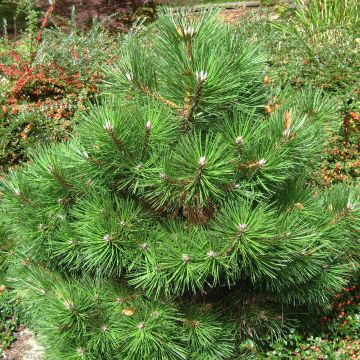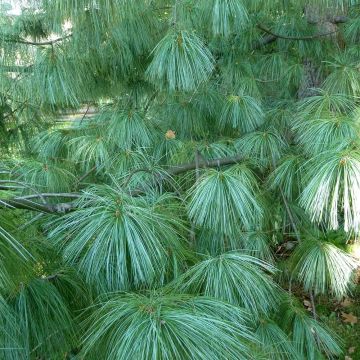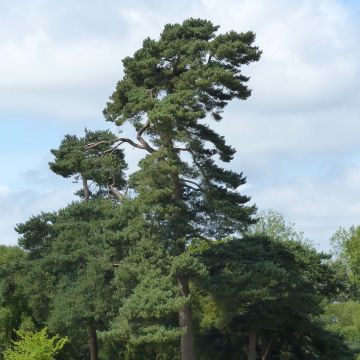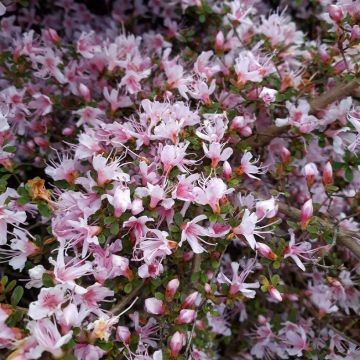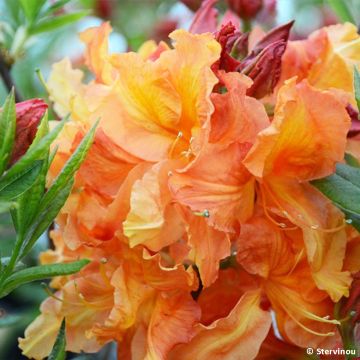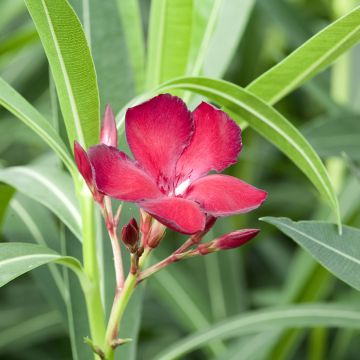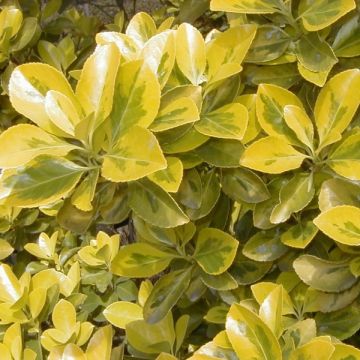

Pinus densiflora Jane Kluis - Japanese Red Pine


Pinus densiflora Jane Kluis - Japanese Red Pine
Pinus densiflora Jane Kluis - Japanese Red Pine
Pinus densiflora Jane Kluis
Japanese Red Pine, Red Pine
This item cannot be shipped to the selected country
Delivery charge from €5.90
Delivery charge from €5.90
Delivery to Corse prohibited
More information
Schedule delivery date,
and select date in basket
This plant carries a 24 months recovery warranty
More information
We guarantee the quality of our plants for a full growing cycle, and will replace at our expense any plant that fails to recover under normal climatic and planting conditions.
From €5.90 for pickup delivery and €6.90 for home delivery
Express home delivery from €8.90.
From €5.90 for pickup delivery and €6.90 for home delivery
Express home delivery from €8.90.
Delivery to Corse prohibited: UE law prohibits the import of this plant from mainland France to Corse as part of the fight against Xylella fastidiosa. Please accept our sincere apologies.
More information


Does this plant fit my garden?
Set up your Plantfit profile →
Description
The natural shape of Pinus densiflora 'Jane Kluis' resembles a slightly wider than tall parasol. This wonderful little red pine from Japan has a remarkable texture and vegetation so dense that it fills all the empty spaces in its branches. At the end of the branches, its big bright, white buds emerge from a fan of long light green needles. In spring, they lengthen into pink to reddish shoots, covered with small light green needles that elongate and darken as they open into a large sun-shaped crown during summer. Its slow growth and small size allow it to fit in small gardens, enliven rock gardens, and stand out in the foreground on a terrace or balcony. It is an ideal variety for the art of bonsai. It enjoys sunlight and well-drained, ordinary soil.
Pinus densiflora, also known as Japanese red pine or Japanese umbrella pine, is a plant from the Pinaceae family native to forests in northeastern China, Korea, and Japan. In its natural environment, this species can reach heights over 30 m (98.4 ft) and has a variable habit, a naturally twisted shape, and often multiple trunks covered with red bark. Appreciated for its wood in Japan, this species also provides shade for the cultivation of matsutake, a highly aromatic mushroom.
The 'Jane Kluis' variety distinguishes itself from the wild species by its reduced size and its naturally dense tabular habit, which can be further enhanced by pruning in May-June. Its growth is very slow, so that at the age of 10 years, it will reach approximately 50 cm (19.7 in) in height and have a spread of 1.50 m to 2 m (4.9 ft to 6.6 ft). Its often twisted trunk bears almost horizontal branches, from which orange bark-covered twigs emerge. This turns grey and peels off in sheets with age. It is covered with fine needles, 10 cm (3.9 in) long, grouped in pairs and arranged in flat crowns. The big white buds that appear in September at the centre of the fans, at the ends of the branches, contribute greatly to the aesthetics of this variety. They take on lovely shades as they bloom. The shoots located in the centre of the branches are the largest and occupy the upper space, while the lateral, smaller shoots fill the peripheral space.
Japanese red pine 'Jane Kluis' is ideal in even the smallest gardens, whether as a standalone specimen, in a rock garden, or in the back of a border. It will make a magnificent subject in a pot that enhances a balcony or terrace. It works wonders in a Japanese garden and pairs well with large rocks, geometric lines of swimming pools, and masonry works. It can be combined with complementary grasses or dwarf conifers with prostrate habit (Juniperus horizontalis 'Blue Chip'), globose habit (Picea abies 'Little Gem'), or columnar habit (Juniperus communis 'Sentinel'). The visual qualities of conifers naturally impose themselves in the design of a contemporary garden, which prefers the aesthetics of shapes, silhouettes and textures to the daintiness of flowers. This plant is a perfect alternative to trimmed boxwood or holly, and can be used to mark pathways or border terraces. They also add permanence to the structure of a flowerbed. The key is to play with volumes and colours.
Report an error about the product description
Pinus densiflora Jane Kluis - Japanese Red Pine in pictures




Plant habit
Foliage
Botanical data
Pinus
densiflora
Jane Kluis
Pinaceae
Japanese Red Pine, Red Pine
Cultivar or hybrid
Other Pinus - Pine
Planting and care
Pinus densiflora 'Jane Kluis' can be planted from September to November and from February to June in ordinary, rather fertile, well-drained but moist soil. Adding ericaceous soil during planting will help it establish in the garden. Choose a very sunny location. Soak the root balls well before planting. Add organic matter during planting. Water generously in the first years and during prolonged drought. Apply a special conifer fertiliser every year in April and weed the soil in summer. This hardy conifer (up to -20° C (-4° F) at least) is not afraid of wind, but it dislikes prolonged drought. To accentuate the bush's habit, an annual light pruning can be done between May and June, by shortening the young shoots. Pruning of branches can be done from September to November.
Planting period
Intended location
Care
-
, onOrder confirmed
Reply from on Promesse de fleurs
Evergreen shrubs
Haven't found what you were looking for?
Hardiness is the lowest winter temperature a plant can endure without suffering serious damage or even dying. However, hardiness is affected by location (a sheltered area, such as a patio), protection (winter cover) and soil type (hardiness is improved by well-drained soil).

Photo Sharing Terms & Conditions
In order to encourage gardeners to interact and share their experiences, Promesse de fleurs offers various media enabling content to be uploaded onto its Site - in particular via the ‘Photo sharing’ module.
The User agrees to refrain from:
- Posting any content that is illegal, prejudicial, insulting, racist, inciteful to hatred, revisionist, contrary to public decency, that infringes on privacy or on the privacy rights of third parties, in particular the publicity rights of persons and goods, intellectual property rights, or the right to privacy.
- Submitting content on behalf of a third party;
- Impersonate the identity of a third party and/or publish any personal information about a third party;
In general, the User undertakes to refrain from any unethical behaviour.
All Content (in particular text, comments, files, images, photos, videos, creative works, etc.), which may be subject to property or intellectual property rights, image or other private rights, shall remain the property of the User, subject to the limited rights granted by the terms of the licence granted by Promesse de fleurs as stated below. Users are at liberty to publish or not to publish such Content on the Site, notably via the ‘Photo Sharing’ facility, and accept that this Content shall be made public and freely accessible, notably on the Internet.
Users further acknowledge, undertake to have ,and guarantee that they hold all necessary rights and permissions to publish such material on the Site, in particular with regard to the legislation in force pertaining to any privacy, property, intellectual property, image, or contractual rights, or rights of any other nature. By publishing such Content on the Site, Users acknowledge accepting full liability as publishers of the Content within the meaning of the law, and grant Promesse de fleurs, free of charge, an inclusive, worldwide licence for the said Content for the entire duration of its publication, including all reproduction, representation, up/downloading, displaying, performing, transmission, and storage rights.
Users also grant permission for their name to be linked to the Content and accept that this link may not always be made available.
By engaging in posting material, Users consent to their Content becoming automatically accessible on the Internet, in particular on other sites and/or blogs and/or web pages of the Promesse de fleurs site, including in particular social pages and the Promesse de fleurs catalogue.
Users may secure the removal of entrusted content free of charge by issuing a simple request via our contact form.
The flowering period indicated on our website applies to countries and regions located in USDA zone 8 (France, the United Kingdom, Ireland, the Netherlands, etc.)
It will vary according to where you live:
- In zones 9 to 10 (Italy, Spain, Greece, etc.), flowering will occur about 2 to 4 weeks earlier.
- In zones 6 to 7 (Germany, Poland, Slovenia, and lower mountainous regions), flowering will be delayed by 2 to 3 weeks.
- In zone 5 (Central Europe, Scandinavia), blooming will be delayed by 3 to 5 weeks.
In temperate climates, pruning of spring-flowering shrubs (forsythia, spireas, etc.) should be done just after flowering.
Pruning of summer-flowering shrubs (Indian Lilac, Perovskia, etc.) can be done in winter or spring.
In cold regions as well as with frost-sensitive plants, avoid pruning too early when severe frosts may still occur.
The planting period indicated on our website applies to countries and regions located in USDA zone 8 (France, United Kingdom, Ireland, Netherlands).
It will vary according to where you live:
- In Mediterranean zones (Marseille, Madrid, Milan, etc.), autumn and winter are the best planting periods.
- In continental zones (Strasbourg, Munich, Vienna, etc.), delay planting by 2 to 3 weeks in spring and bring it forward by 2 to 4 weeks in autumn.
- In mountainous regions (the Alps, Pyrenees, Carpathians, etc.), it is best to plant in late spring (May-June) or late summer (August-September).
The harvesting period indicated on our website applies to countries and regions in USDA zone 8 (France, England, Ireland, the Netherlands).
In colder areas (Scandinavia, Poland, Austria...) fruit and vegetable harvests are likely to be delayed by 3-4 weeks.
In warmer areas (Italy, Spain, Greece, etc.), harvesting will probably take place earlier, depending on weather conditions.
The sowing periods indicated on our website apply to countries and regions within USDA Zone 8 (France, UK, Ireland, Netherlands).
In colder areas (Scandinavia, Poland, Austria...), delay any outdoor sowing by 3-4 weeks, or sow under glass.
In warmer climes (Italy, Spain, Greece, etc.), bring outdoor sowing forward by a few weeks.

































